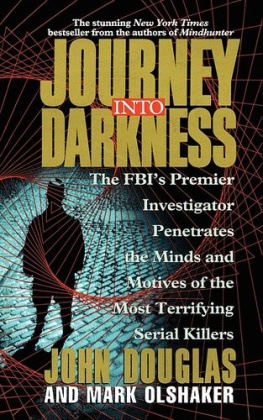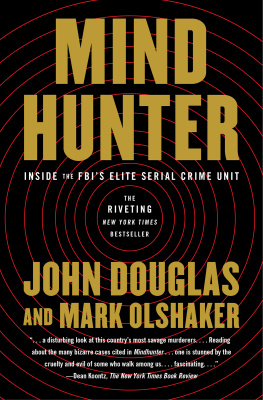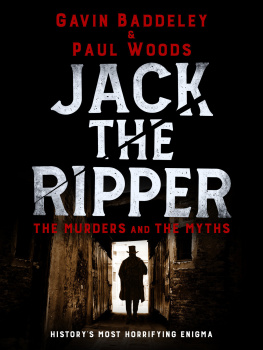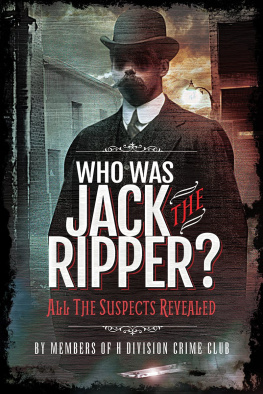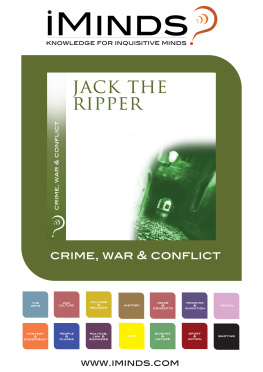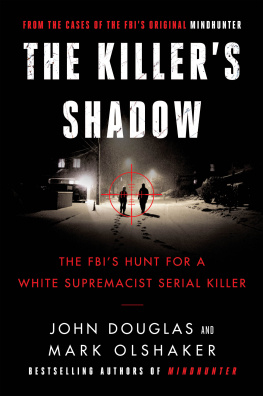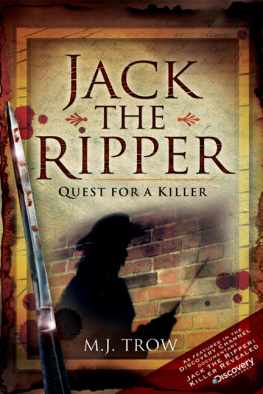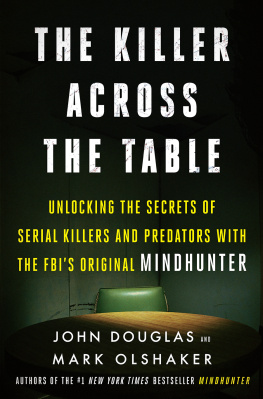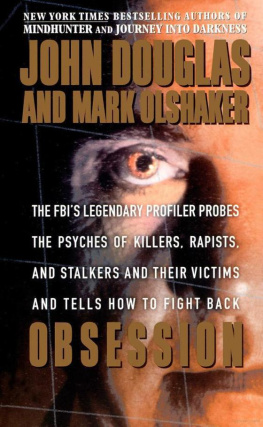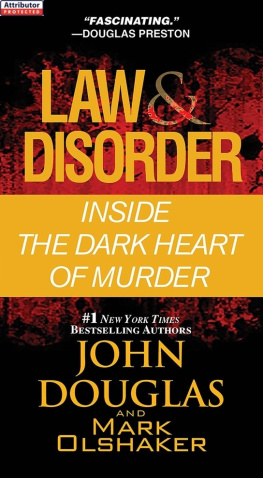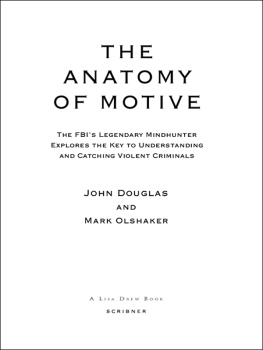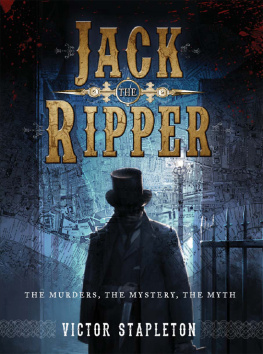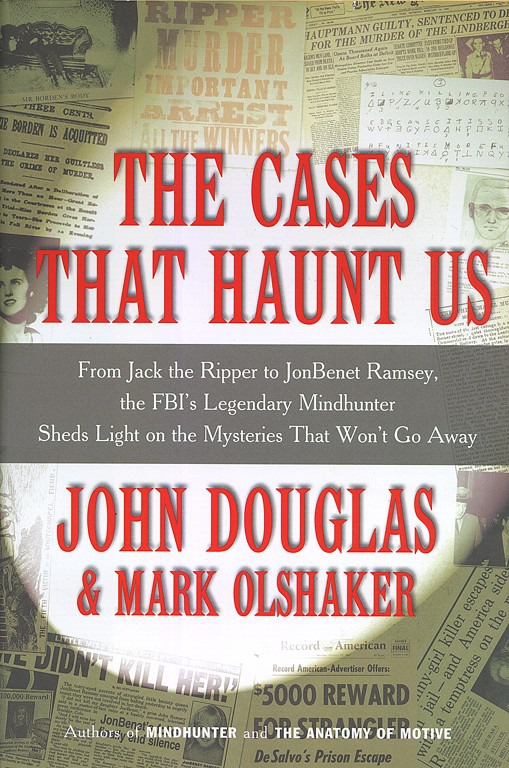BY THE SAME AUTHORS
NONFICTION
Mindhunter
Inside the FBIs Elite Serial Crimes Unit
Unabomber
On the Trail of Americas Most-Wanted Serial Killer
Journey into Darkness
Obsession
The Anatomy of Motive
FICTION
Broken Wings
BY JOHN DOUGLAS
Sexual Homicide
Patterns and Motives
with Robert K. Ressler and Ann W. Burgess
Crime Classification Manual with
Ann W. Burgess, Allen G. Burgess, and Robert K. Ressler
John Douglass Guide to Careers in the FBI
BY MARK OLSHAKER
NONFICTION
The Instant Image
Edwin Land and the Polaroid Experience
Virus Hunter
Thirty Years of Battling Hot Viruses around the World
with C. J. Peters, M.D.
FICTION
Einsteins Brain
Unnatural Causes
Blood Race
The Edge
ANTHOLOGY
Unusual Suspects
edited by James Grady

SCRIBNER
1230 Avenue of the Americas
New York, NY 10020
www.SimonandSchuster.com
Copyright 2000 by Mindhunters, Inc.
Originally published in hardcover in 2000 by Scribner
All rights reserved, including the right to reproduce this book or portions thereof in any form whatsoever. For information address Scribner, 1230 Avenue of the Americas, New York, NY 10020
SCRIBNER and design are trademarks of Macmillan Library Reference USA, Inc., used under license by Simon & Schuster, the publisher of this work.
A LISA DREW BOOK is a trademark of Simon & Schuster, Inc.
For information regarding special discounts for bulk purchases, please contact Simon & Schuster Special Sales at 1-866-506-1949 or
The Simon & Schuster Speakers Bureau can bring authors to your live event. For more information or to book an event, contact the Simon & Schuster Speakers Bureau at 1-866-248-3049 or visit our website at www.simonspeakers.com.
ISBN 978-0-6710-1706-4
ISBN 978-0-7432-1239-7 (ebook)
AUTHORS NOTE
As usual, we are indebted to many people for making this book possible:
Our brilliant and insightful editor, Lisa Drew, always there for us.
Our agent and close friend, Jay Acton, who has shaped our writing careers and everything that goes with them.
Ann Hennigan, dauntless and intrepid Mindhunters research coordinator, who makes sure we know what we need to.
Katherine Johnston Ramsland, Ph.D., accomplished author in her own right, who researched and worked up these cases for us and then played the role of local law enforcement agency to Johns mindhunting.
Jake Klisivitch, Lisas assistant and the one who kept us on track and put together all the pieces.
Martin Fido, distinguished and prolific author, scholar, criminologist, and now good friend, for his extraordinary contributions to the Jack the Ripper case and our understanding of it, as well as his general good counsel.
Mark W. Falzini, New Jersey State Police archivist, for his hugely valuable help on the Lindbergh kidnapping case.
Leonard Rebello, Fall River historian, for equally valuable assistance on the Borden case, photos, and generosity in reviewing the Borden chapter.
Donald Rumbelow, another of the foremost Ripper experts, for his wonderful book and profound personal insights.
Paul Cardalucci and the other teachers, staff, and residents of High-fields school, formerly the Lindbergh house, Hopewell, New Jersey, for their gracious hospitality and fascinating tour.
John Ross, curator of the Museum of Crime, the famous Black Museum, New Scotland Yard; writer Kris Radish; Martha and Sally McGinn and the staff of the Lizzie Borden Bed and Breakfast, Fall River, Massachusetts, for all of their consideration and kindness.
And, as always,
Carolyn C. Olshaker, without whose help... well, we all know the rest.
JOHN DOUGLAS AND MARK OLSHAKER
June 2000
How often have I said to you that when you have eliminated the impossible, whatever remains, however improbable, must be the truth?
SIR ARTHUR CONAN DOYLE,
The Sign of Four
INTRODUCTION
On its most essential level, criminology is about why people do the things they do; that is, it is about the human condition. And of all the millions of horrendous crimes that have been committed over the years, certain criminal cases seem to have lives of their own. Despite the passage of time, they continue their hold on our collective imagination, and our collective fears. For some reason, each of these cases and the stories surrounding them touches something deep in that human conditionbecause of the personalities involved, the senseless depravity of the crime, the nagging and persistent doubts about whether justice was actually done, or the tantalizing fact that no one was caught. In any event, the case remains a fascinating and perplexing mystery and gets to the core of how we see ourselves as human beings and our relationship to society.
Each of the cases well be examining in this book has remained extremely controversial. And each of these cases contains some universal truth at its base to which we can all relate. Taken together, they present a panorama of human behavior under extreme stress and an inevitable commentary on good and evil, innocence and guilt, expectation and surprise.
Through the cases well examine, we hope to show the uses, benefits, and limitations of modern behavioral profiling and criminal investigative analysis as practiced by the behavioral science units of the National Center for the Analysis of Violent Crime at the FBI Academy in Quantico, Virginia. The operational division that actually does the profiling and case consultations has undergone several changes of name and designation. At the time that I was its chief until my retirement in 1995, it was known as the Investigative Support Unit, or ISU. Sometimes, we can go a long way in determining the identity of an unknown offender. Sometimes, we can only say who it is not. Sometimes, we cant do either. But weve greatly improved our ability to interpret forensic evidence from a behavioral standpoint. Had the discipline been around at the time of the earliest cases in this book, I believe we would have solved them and delivered the offenders to justice.
We will be focusing on several key themes that will be familiar to readers of our previous books. One is motive: why an individual decided to do what he did and how we try to determine that. Another is the evolution and development of the criminal: you dont just wake up one morning and commit any of these crimes without prior behavioral indicators and a specific precipitating stressor. A third is postoffense behavior: how an individual who has committed a serious crime may be expected to act and react afterward. All of these factors will go into our evaluations.
Lets get down to the nitty-gritty. Are we going to be able to solve each of these crimes that have tantalized and eluded experts for years, decades, or in two instances, more than a century?
Frankly, thats doubtful.
What we are going to do is to approach each one to some extent differently than its been approached in the past. Were going to look at and examine each one as I would have as a profiler and criminal investigative analyst for the FBI. Were going to use the crimes and crime-scene evidence to indicate the type of individual we should be looking for. Then well evaluate the subjectsthose suspected, accused, and/or convicted of the crimeto see how well they fit in.
In much of the revisionist-theory industry surrounding these cases, writers tend to decide what they think and then employ the evidence to support that theory. Then they essentially challenge skeptics to prove a negative. Among the examples of this phenomenon, which will become clear as you read on:

